THE AWARD-WINNING architecture firm, Francis-Jones Morehen Thorp (FJMT) may have its offices in Australia and the United Kingdom, but its origins are firmly American. The practice grew out of the renowned American architecture firm of Mitchell | Giurgola whose work rose to prominence throughout the US and abroad back in the 1960’s. In 1980, Romaldo Giurgola lead the design for the firm’s competition-winning commission for the new Australian Parliament House in Canberra. He opened Mitchell, Giurgola & Thorp in Canberra, and eventually an office in Sydney.
“Romaldo actually stayed in Australia,” says Johnathan Redman, principal at FJMT. Indeed, the celebrated architect and professor, whom architectural critic Jan Rowan grouped with Louis Kahn and Robert Venturi, among others, into the “Philadelphia School,” would eventually become an Australian citizen in 2000. Today the offices in Melbourne and Sydney constitute FJMT’s footprint in Australia and extend from the legacy of Romaldo Giurgola and his competition-winning design.

01 – FJMT Principal, Johnathan Redman, in Kyoto, Japan, discusses the firm’s architecture and technology at the 2017 KCC.
A speaker at the 2017 GRAPHISOFT Key Client Conference (KCC) in Kyoto, Japan, Johnathan’s presentation on FJMT offered a remarkable perspective on the notion of architectural craft in the era of BIM. And it sounds like a big part of that outlook descends back to Giurgola’s winning entry for the Parliament House.
With Great Scale Comes Great Needs
Redman explained that it was the massive commission for the Parliament House that set the firm on course towards computerization, not literally in the sense that project was the first actual CAD project in-house but instead it was large commissions like it that forced talented hands to consider the power of the computer.
We like to push the boundaries and say, ‘what is possible within ARCHICAD?’
“I think we realized in the early 90’s that CAD technology was something we really had to embrace,” he says, “and that was around the time when I started. And when I did start I was drawing on vellum with ink. People were taking great pride in the works of art they were drawing by hand back then.” But Redman noted that the firm recognized it needed to be more “nimble” and invested in big—and expensive—Intergraph workstations. “We had one that sat in the corner, and then we decided to get two more,” he says. “And we thought, ‘why not get cheaper computers and lots of them,’ so that’s when we went for putting a computer on every desk.”
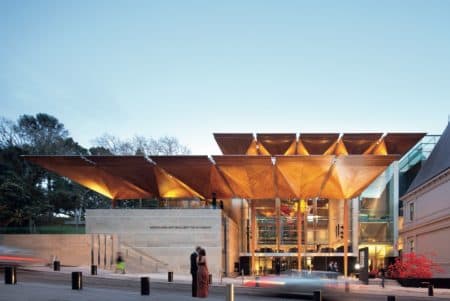
02 – FJMT designed this award-winning addition/renovation to the Auckland Art Gallery. (image: FJMT-Gollings / Architosh. All rights reserved)
The firm went from having talented architects with drawing boards at every desk to have a Mac with Microstation sitting beside them somewhat overnight. “We would do everything in CAD in the early days except the detailing, which we did by hand,” says Redman, who is the firm’s senior-most leader in charge of information technologies. Eventually, the firm needed a 3D tool. “We started looking at TriForma but it was the early days of TriForma,” he added. The firm eventually rejected that direction due to the complexity of the software.
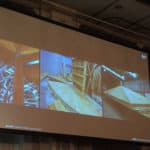
04 – The precise geometry of these canopies went from the digital to the physical prototype-build process.
“That was disappointing because we were working on an important project collaborating with a firm in Perth and although they weren’t using it themselves they said, ‘why not look at ARCHICAD?’ So we did.”
From Mainframe to ARCHICAD
Redman recalls that at one time the firm had a mainframe computer to power and support a huge staff. They also had a dedicated technician for the few Intergraph workstations they had positioned in the corner of the office. But despite that history, and with those oppositional forces of ‘works-of-art’ by hand and mainframe power, the firm’s architects have tended to embrace the computer.
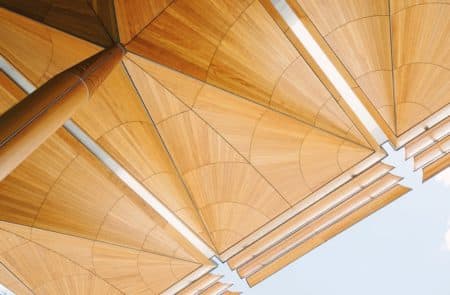
05 – The new building addition is characterized by these canopies that recall the nearby Pohutukawa trees. (image: The Auckland Art Gallery / Architosh. All rights reserved.)
In fact, in today’s FJMT studios the word “embrace” might be too meek a word. The award-winning Australian and UK architecture firm is not only BIM-savvy but producing extraordinary works of architecture thanks to the power of algorithmic 3D modeling and digital-to-physical prototyping. In 2001 the company had entirely moved over to GRAPHISOFT’s ARCHICAD BIM platform running on a fleet of Apple Macs for an office that today is more than 130 in just the Australian offices.
As noted at the 2017 KCC in Kyoto, the firm’s use of the Rhino-Grasshopper-ARCHICAD connection, also known just as RGA, was well utilized. One of the critical projects Redman presented in his talk is the Auckland Art Gallery Toi O Tamaki, with its tree-like canopies that provide building and zone definition as well as a unique architectural identity for a public structure. The wood ceilings of the canopies are complex geometric assemblies of Kauri wood and their 3D modeling and design took the power of ARCHICAD with Grasshopper for their creation.
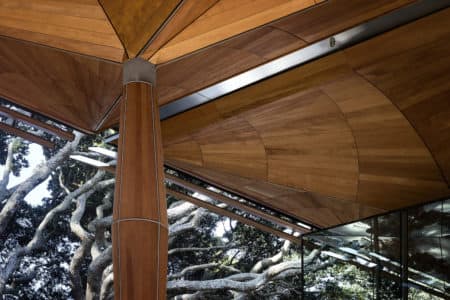
06 – ARCHICAD and Grasshopper were used to design these complex forms and the end results are stunning. (image: FJMT-Reynolds / Architosh. All rights reserved)
“We have one guy who is a specialist, and that’s all he does,” says Redman, speaking about advanced Rhino and Grasshopper utilization in the firm. “But what he serves is as a focal point for the people in the firm who have those skills. So he goes around and communicates and gives people tips on how to do things.” He estimates that about 10 percent of the office have Rhino or Grasshopper skills or both and are using those tools throughout the firm at various levels.
You find these people with these skills and get them started on something that evolves, and they introduce new things, and suddenly there is something in the practice we’ve never had before…
“I think that is not too bad because of the practice structure—which is a team-based structure. We want to distribute the skills around to the teams,” says Redman. The argument is valid. Rather than have a specialist doing part of a project for a team, the specialist—which some firms might call a “computational architect”—helps to foster the skills in the office, develop techniques, but disseminate that information to others.
“He is also doing research and pushing the edge of what we can do with these tools.”
A Practice Structure for Craftsmanship and Design Excellence
FJMT appears to be ideally structured for architectural innovation. Published in 2013 by ORO Editions, the firm’s monograph is titled “Architecture as Material Culture: The works of Francis-Jones Morehen Thorp,” and written by Kenneth Frampton, one of the world’s most celebrated architectural historians.
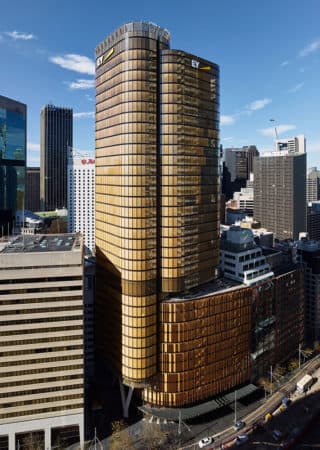
07 – The EY Centre is a tower of wood, warm and responsive—a sustainable workplace. (image: FJMT / Architosh. All rights reserved).
What stood out about the firm’s work from Redman’s talk in Kyoto was its emphasis on tectonics or the craft of assemblies. The firm is active in direct research and development, principally in the areas of material systems and environmental analysis and simulation. Both of these areas benefit from the advanced computational methods inherent in algorithmic computational tools like Grasshopper, which today can power advanced 3D modeling features in ARCHICAD.
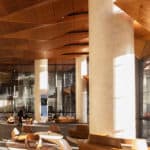
09 – A finished view of the EY Centre lobby and ceilings. (image: FJMT / Architosh. All rights reserved.)
The firm is increasingly exploring more complex assemblies, organic forms, and intricate environmentally-driven building facades and building envelopes. This kind of work is also getting more comfortable to do directly in ARCHICAD itself thanks to its industry-leading stair tool in the latest software release. FJMT’s project, the Charles Perkins Centre, features the dramatically curved stairs that grace the ARCHICAD 21 product box.
“We like to push the boundaries and say, ‘what is possible within ARCHICAD?’, says Redman. The firm is fortunate to possess a former GRAPHISOFT employee and native son of Hungary, in Tony Krepler, who acts as BIM Manager. “We are a team of two,” says Krepler of his work with Redman. “We try to make it easy-to-use for everybody, and I am not just talking about ARCHICAD, but also dRofus, Solibri, Rhino, and Grasshopper. And we try to take every opportunity because these tools don’t just work in isolation; we are deeply involved in workflows that work for the firm.”

10 – The facade consists of multiple layers, isolating automated blinds made of wood within a vacuum airspace with high-performance double-layer glass on the inward side. Rich, warm, and energy performant. (image: FJTM / Architosh. All rights reserved.)
And they are working for the firm—at the highest level. “Sometimes Richard Francis-Jones (the firm’s director of design) sits down with someone with Grasshopper and makes that part of a form-finding exercise,” adds Redman.
Design Decisions Filter Up—And Up Is Where This Firm is Headed
While Francis-Jones is the ultimate authority on design decisions at the firm, the practice is structured around teams with each team led by a principal. The principals are responsible for the management of the projects. “Obviously there is a kind of filtering up of design decisions, from finer grain to bigger decisions…and the principals act as the filter for that process—to bring things to Richard’s attention,” says Redman.
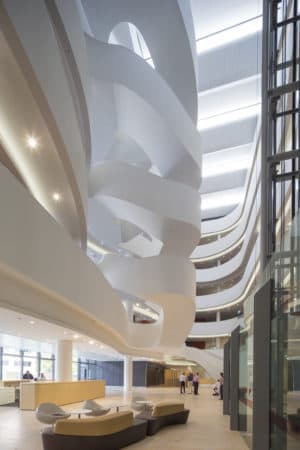
11 – A health sciences research building, the Charles Perkins Centre boasts dramatic stairs featured on the ARCHICAD 21 box.
This same approach just extends down through the team. “This empowers junior staff to make decisions on what they are working on,” he adds. “You find these people with these skills and get them started on something that evolves, and they introduce new things, and suddenly there is something in the practice we’ve never had before,” says Redman. “So it’s kind of this organic idea of how things grow up in the firm, not just top-down, and the design hierarchy, if you want, can shift and choose and curate on that layer of design ideation.”
This process of filtering up innovative ideas from junior firm members who possess new skills is also reflective of how the firm goes to builders and craftspeople early in the process. It’s not just embracing craftsman, its embracing expertise. “We recognize they have skills we do not,” Redman says, “and can take it only to a certain point and so we often engage with them early.”

12 – ARCHICAD 21 made designing these stairs a breeze for FJMT Studio. (image: FJMT / Architosh. All rights reserved.)
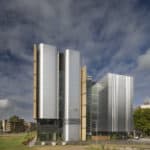
13 – An exterior view of the Charles Perkins Centre. (image: FJMT / Architosh. All rights reserved.)
While some may view contemporary architectural practice and its output as too reflective of the limitations of the digital tools—namely the automating tendencies of BIM—that architects rely on, Francis-Jones Morehen Thorp is defying that perception. By combining clear design philosophies with a filter-up office culture and embrace of advanced algorithmic design methods, FJMT is exceptionally well positioned to continue to exceed both client and cultural expectations for architectural practice in the 21st century.
Image Credits
Format equates to “party with copyright” / “party with reserved rights of use.” (eg: image: FJMT / Architosh. All rights reserved.)
Title image credit: The Auckland Art Gallery. All rights reserved. Not credited images are copyrighted to Architosh. All other images are copyrighted, as noted in the image credits.


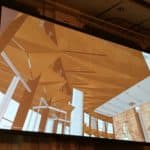



Reader Comments
Comments for this story are closed